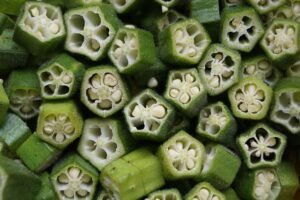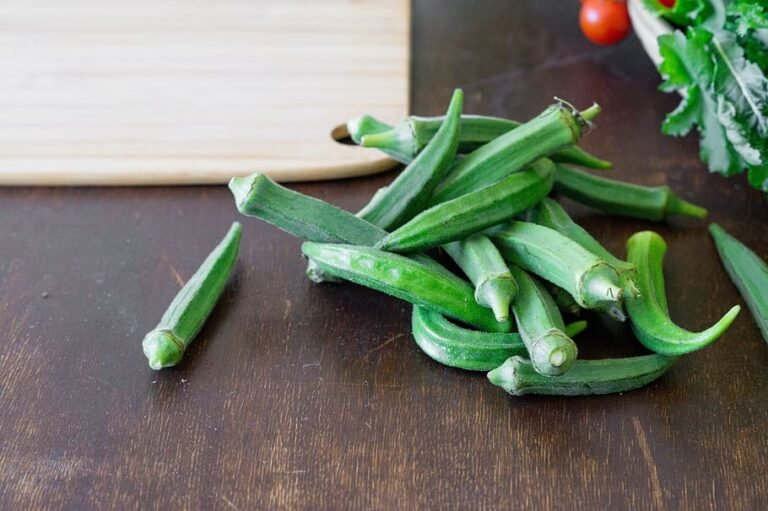Overview
Lady Finger (Okra Plant, Bhindi) is a green vegetable that looks like a long, skinny pod. Some people call it okra. It’s used in cooking in places like Asia, the Middle East, and the Caribbean. When you cook it, it becomes a bit slimy, which some folks like and others don’t. But it’s good for you because it has stuff like fiber, vitamins, and antioxidants.
Now, when it comes to desserts, there’s another thing called ladyfingers. They’re like soft, spongy cookies or cakes. You might find them in fancy desserts like tiramisu. People soak them in sugary liquid to make them tasty and soft. Then they layer them with creamy stuff like cheese or custard.
So whether you’re making a hearty stew with okra or a fancy dessert with ladyfingers, both types of Lady Finger add their own special flavor and texture to dishes.In India, it is cultivated at an altitude of about 1200 m. It is used as a herb.
Lady Finger (Okra Plant, Bhindi ) in Your Language
Botanical Name of Lady Finger (Okra Plant, Bhindi,Gumbo)
Moench (Abelmoschus esculentus)
Common Name of Lady Finger (Okra Plant, Bhindi)
Okra, Gumbo, Bendi (Bindi,Bhindi )
Family of Lady Finger (Okra Plant, Bhindi ,Gumbo)
Malvaceae (Malvaceae)
Lady Finger-Okra-Gumbo in English
Lady’s finger (Lady Finger)
Synonyms of Lady Finger-Gumbo-Okra
Hibiscus esculentus
Lady Finger-Gumbo-Okra in Sanskrit
Tindisha, Bhenda, Karparnphal, Gandhmoola; (तिण्डिशा, भेण्डा, करपर्णफल, गन्धमूला )
Lady Finger-Gumbo-Okra in Hindi
Bhindi, Ramtorai (भिण्डी, रामतोरई )
Lady Finger-Gumbo-Okra in Urdu
भिन्डी (Bhindi),بھنڈی
Lady Finger-Gumbo-Okra in Kannada
बेन्डेकायी (Bendekayi) ,ಬೆಂಡಕಾಯಿ
Lady Finger-Gumbo-Okra in Gujarati
भिंडो (Bhindo) ,ભીંડો
Lady Finger-Gumbo-Okra in Tamil
वेन्डी (Vendi) ,வெண்டி
Lady Finger-Gumbo-Okra in Telugu
वेन्डा (Venda) ,వెండా
Lady Finger-Okra Plant in Bengali
भेण्डी (Bhendi), ढेरासा (Dherasa)
Lady Finger-Okra Plant in Nepali
रामतोरिया (Ramturiya)
Lady Finger-Okra Plant in Punjabi
ਭੀੰਡੀ ,Bhindi ,Bhenda ਭੇੰਡਾ
Lady Finger-Okra Plant in Malayalam
വെണ്ട-Vanta
Lady Finger-Okra Plant in Marathi
भेण्डी
Lady Finger-Okra Plant in English
भेण्डी
Physical Appearance of Lady Finger/Okra
Ladyfinger, also known as okra or bhindi, is a flowering plant with edible green pods. Here’s a description of its physical appearanc:
Plant Structure: Ladyfinger plants are usually herbaceous, meaning they have soft, green stems that are not woody. They can grow up to 6-7 feet in height.This is a plant that is 0.5-2 meters tall
Leaves: The leaves of the ladyfinger plant are palmate, meaning they have lobes that radiate from a central point, somewhat resembling the shape of a hand. They are green and can vary in size but are generally large compared to the size of the plant. Its leaves are large, broad, toothed, resembling those of cotton, with a heart shape base, 5-25 cm long and 5-30 cm wide, with 3-5 lobes, and are green in color.
Flowers: Ladyfinger plants produce yellow flowers with a red or maroon center. These flowers are usually quite large and have five petals. They typically bloom for a short period before giving way to the development of the pods.Its flowers are yellow with a dark red spot in the center. Its fruits are long, spindle-shaped, seven-angled, 15-20 cm long, 2.5 cm wide, green, and covered with hairs.
Pods: The most distinctive feature of ladyfinger plants is their elongated, slender green pods. These pods are usually harvested when they are immature and tender. They can vary in length from a few inches to around a foot long, depending on the variety. Ladyfinger pods have a slightly ridged surface and contain small, white seeds.
Texture: Ladyfinger pods have a slightly fuzzy texture on the outside due to fine hairs. The inner flesh is soft and mucilaginous when cooked, giving it a somewhat slimy texture that is prized in certain cuisines for its thickening properties.





Chemical Composition of Lady Finger/Okra
Benefits of Lady Finger/Okra ( Uses of Lady Finger/Okra ) + Medicinal uses of Lady Finger/Okra
Gastrointestinal Disorders
- Consumption of cooked okra vegetable prepared from okra fruit helps alleviate diarrhea and dysentery.
- Eating cooked okra vegetable made from okra fruits benefits in amoebic dysentery.
Urinary Disorders
- Drinking a decoction made from okra fruit in a dosage of 10-15 milliliters helps alleviate urinary retention, urinary tract inflammation, and urinary tract infections.
- Consuming a decoction made from okra flowers mixed with 10-15 milliliters of honey helps in urinary retention, urinary obstruction, and urinary burning sensation.
- Consuming 1-2 grams of powdered okra roots mixed with honey helps in diabetes mellitus.
Reproductive System Disorders
- Consumption of 5-10 milliliters of okra fruit decoction benefits in male infertility.
- Consuming 15-20 milliliters of okra fruit decoction benefits in leukorrhea.
- Taking 1-2 grams of powdered okra root three times a day for a month helps in various vaginal disorders.
- Drinking a mixture of crushed okra fruits and honey aids in spermatorrhea, inflammation, leukorrhea, and diarrhea.
Skin Disorders
- Applying a paste of crushed okra leaves on wounds helps in faster wound healing.
- Okra leaf juice is highly beneficial when applied to cuts, injuries, and skin inflammations.
- Applying a paste of crushed pumpkin fruit helps in treating itching.
Whole Body Disorders
- Applying a paste of crushed okra leaves on burnt areas helps soothe burns.
Frequently Asked Questions 👇 (FAQ)
Back To Home


“Ayuage.com is an outstanding platform for anyone interested in herbal remedies. The guides on herbs for immunity, digestion, and stress relief are very clear and easy to follow. I especially like that precautions are included for each herb, making it safe to try. I have tried several remedies and found them effective. The website is professional, informative, and trustworthy. I highly recommend it to anyone looking for natural ways to maintain health.”